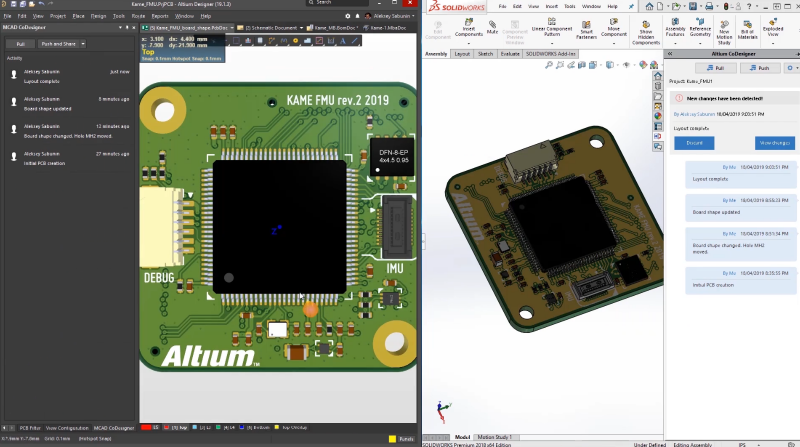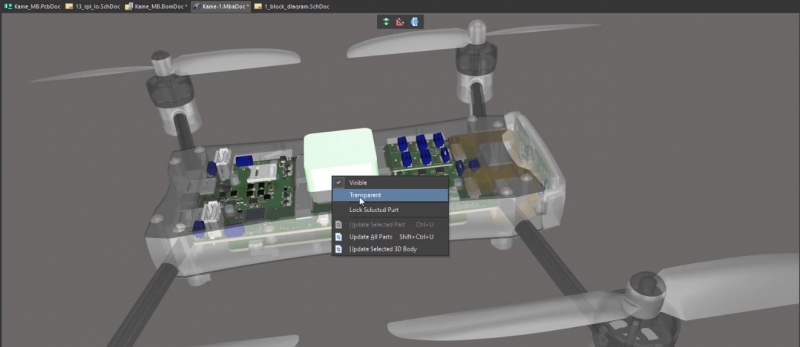How to Keep Your 3D PCB Models Current with Data Management Tools
Any component includes a significant amount of design data. This includes electrical models, 3D component models, and PCB supplier information. Your PCB design software should be allowed to take this data and integrate it with your MCAD tools. This allows you to create 3D body models from your PCB footprints and integrate them into a data library.
Ensuring that this data stays up to date takes a data management platform that operates directly alongside your PCB design features. When you have access to a complete set of data management tools within your design software, you can easily create 3D body models for your PCB design that stay current with the latest design data. With the MCAD integration and supply chain visibility tools in Altium Concord Pro, you can ensure to keep your PCB libraries up to date and manage all aspects of your design in a single program.
ALTIUM CONCORD PRO®
A unified data management and 3D model integration platform that integrates with Altium Designer® and other mechanical design tools.
PCB libraries are often taken for granted by new designers, but they are vitally important in the PCB design process. During layout, you’ll need to use CAD software and routing tools to arrange and connect components throughout your board. Each component has an associated electrical model and a footprint, and each component footprint will appear in your board as part of a 2D CAD drawing of each layer on your board. However, components for printed circuit boards also have 3D models. All this data on your components and your PCB footprints can be packaged into a library for easy transfer and access.
Your PCB libraries make collaboration very easy, and the right 3D CAD software allows you to build 3D models for new components or integrate your PCB design data into mechanical models. But how can you be sure that your component models and footprints are current? Whenever updates are applied to old components or new components become available, you‘ll need to quickly import this updated data into your PCB design software.
You shouldn’t have to search component distributors or manufacturers for updated component models, and you shouldn’t have to manually rebuild and recompile design data every time updates are made available. Your PCB design software should include tools updates to CAD models and PCB footprints into your component libraries. You can take full advantage of these capabilities when your design software integrates directly with your favorite 3D CAD software. Altium Concord Pro is the only platform that integrates with Altium Designer, providing a new level of PCB design unification and streamlined data management.
How to Create 3D Models for Mechanical Integration
3D models for PCB components can be created in a variety of 3D modeling software packages. These models can then be exported in standard file formats and imported into your PCB design software and assigned to a component. Once imported, you compile this information into a library, allowing it to be easily accessed within your design software and included in a new project.
The right CAD software for PCB design makes it easy to import a 3D model for a proprietary component. You can also easily create 3D body models as PCB footprints directly from your component data when your PCB design software includes MCAD capabilities. This eliminates the need to use external 3D modeling software to create your 3D component models and assemble 3D body models.
3D Models in Your MCAD Tools for PCB Design
MCAD tools that are integrated with your PCB design software can help you check your component placement tolerances and the overall form factor of your board. If you are designing a rigid-flex PCB or a multi-board system, you can use your MCAD tools to check that your device bends and assembles as you intended without any collisions between components and your board.
This all relies on taking 3D component models from your libraries and manipulating them with your standard PCB design tools. This streamlines your design process as you will not need to export a model between ECAD and MCAD programs, and you won’t have to completely rebuild your design in your MCAD software.
- MCAD tools within your PCB design software not only allow you to examine your mechanical constraints, they also help you avoid component placement errors.
- Ever thought about designing your next PCB in 3D? Try working with integrated ECAD and MCAD design tools.
- Great PCB design tools that include MCAD capabilities should work with standard file formats, particularly STEP models.
Learn more about PCB design software that accepts STEP models.

ECAD/MCAD collaboration in Altium Designer with Altium Concord Pro
Using 3-D Bodies in a PCB Component Footprint
A 3D model that is assigned to a component can appear as part of your PCB when you switch to a 3D view of your board in your PCB design software. Newer PCB design platforms will include capabilities found in 3D modeling software and will give you a realistic view of your finished PCB. This saves you time from building your board in an MCAD program that does not include the ECAD tools you need for PCB design.
If your PCB design software contains the right data management features, you can create a PCB library that contains your footprints and that will appear as a 3D model. Libraries that contain 3D models can then be exported as integrated libraries for use in new projects. This makes collaboration across a design team much easier and expedites design reuse in new projects.
MCAD Data Management Tools for PCB Design
Since your design data needs to stay updated, you need access to a data management tool that provides component updates, including updates for each 3D model that appears in your PCB. Components periodically become unavailable and the supply can change daily, and your design software should help you stay up to date on supply chain changes. This helps prevent your design from falling victim to component obsolescence and changes in your supply chain.
Your data management tools should do more than just retrieve updated component models and include them in your library. If a component in your PCB ever goes obsolete, you’ll need to swap it with a suitable replacement. Your data management software should make this simple, but this is only possible when these features are integrated into the same program as your PCB design tools. This is ECAD and MCAD design at its finest, and it’s all possible through continued integration of formerly disparate design features.
- Libraries that integrate your ECAD and MCAD data work best when they are integrated with a PCB data management platform that provides supply chain visibility.
Learn more about data management and supply chain integration.
- Keeping your data up to date greatly aids manufacturing and assembly. It also helps ensure that your designs comply with important industry standards.
Learn more about data package problems and how to solve them.
- Large and small design firms can greatly benefit from data management practices, both from a data integrity perspective and in terms of productivity.

Packaging design is simple with MCAD integration and Altium Concord Pro
Integrated MCAD and Management Features in Altium Concord Pro
Data management tools don’t have to impede your design productivity. You also shouldn’t have to adapt a third-party tool into your PCB design software for data management. These other management applications also can’t provide the capabilities found in 3D modeling software. Instead, you need to work with a managed data platform that directly passes data updates to your existing PCB libraries and to your MCAD features. When you use Altium Concord Pro, you’ll have access to the only data management tool that works alongside the native 3D design features and PCB layout tools in Altium Designer.
Altium Concord Pro: Unifying Data Management and MCAD for PCBs
Altium Designer is the only printed circuit board design software that places all your design, documentation, component sourcing, and data management features into a single program. Adding a powerful data management solution like Altium Concord Pro to Altium Designer ensures that your design data is always current and allows you to immediately synchronize your design with popular MCAD platforms. You’ll have the tools you need to create a new device for any application.
- Altium Designer includes 3D modeling and design tools that allow ECAD and MCAD design in a single program. The standard layout and routing tools in Altium Designer integrate directly with these 3D design tools.
Learn more about the native 3D design tools in Altium Designer.
- Altium Concord Pro complements Altium Designer as a data management tool that also provides integration with MCAD software. You can keep your PCB libraries and 3D model data updated with Altium Concord Pro.
Learn more about integrating Altium Designer and Altium Concord Pro.
- Altium Concord Pro is the only MCAD integration and data management platform that works with all the design tools in Altium Designer, the industry’s best PCB design platform.
Other MCAD tools don’t include the data management features you need to keep your 3D component models up to date. Those that do, don’t include support for quickly updating your footprints or libraries and they certainly can’t integrate with popular MCAD tools for 3D modeling and enclosure design. Altium has taken design integration to the next level with Altium Concord Pro, the only data management solution that synchronizes design data for your next device with ECAD/MCAD co-design.
Altium continues to lead integration and innovation in the PCB design industry, and Altium wants you to be successful. When you use Altium Concord Pro with Altium Designer, you’ll have access to the AltiumLive forum, design tutorials, webinars and podcasts with industry experts, and an extensive knowledge base with design tips. No other PCB design software company gives you this much support.
Altium Designer has set the standard in PCB design, and Altium Concord Pro is the perfect complement to this unified design platform. The integrated ECAD, MCAD, and data management features will easily pass design data updates between these important design features. You’ll have full control over all aspects of your product in a single platform. Watch your productivity skyrocket when you add Altium Concord Pro to Altium Designer.
